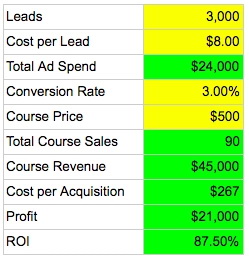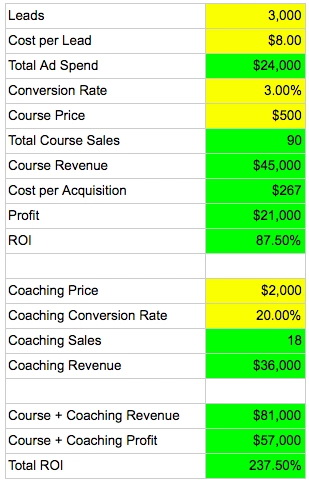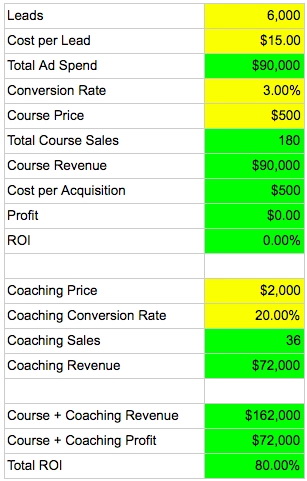Here’s when to use Facebook ads for your online business


“The business that considers itself immune to the necessity for advertising sooner or later finds itself immune to business.”
– Derby Brown
What words come to mind when you hear the term, “Facebook Ads?”
Confusing?
Overwhelmed?
All of the above?
Totally understand. Facebook ads can be daunting and overwhelming, but this post will help.
If you’re a business owner or marketer reading this, the word that should come to mind is opportunity. Because nothing I’ve seen can grow a business as quickly as Facebook Ads.
But they can also sink a business. With the wrong strategy and inaccurate tracking, Facebook Ads can be like a gaping hole in the hull of a boat. The larger the boat (or business), the longer it’ll take to sink. But sink it will.
Even if you’ve done a stellar job getting your business off the ground without using ads, you’ll eventually hit a ceiling. Thanks to the hefty competition for attention on social media, what Derby Brown said in that quote above is more true today than ever before.
If you want to get your product in the hands of more customers, at some point you’ll need to pay for it.
What I’m about to share comes from my experience in the trenches using Facebook Ads to grow a prior business of mine—and more recently, from helping other online businesses grow using Facebook Ads.
Despite what you may hear, Facebook Ads still work like crazy for selling online courses! For example, a very successful client of mine named Caitlin Pyl has built a 7-figure business selling proofreading courses (yep!) and more recently launched course teaching work-from-home skills.Here’s what told me about how advertising has helped grow her course business:
“Advertising on Facebook has been a game changer for us. Each month it allows us to reach thousands of new people who never would’ve heard of us otherwise. Now we are able to build relationships with them by giving away valuable content, and some of those people go on to enroll in our online courses. The result is that we’re well on our way to building an 8-figure education business.”
– Caitlin Pyle, founder of BCP Media
In this article, I’ll help clear the confusion around how to use Facebook Ads. I’ll show you the strategies that successful online businesses are using. And I’ll help you decide if (or when) Facebook Ads are a good fit for your business.
Let’s dive into it by meeting an online business owner who was able to grow exponentially by adding Facebook Ads to the mix.
The Most Difficult Phase of Growing a Business
When one of Elon Musk’s SpaceX rockets takes off, most of its fuel is spent getting off the ground.
It’s the same thing with growing a business. You may have heard a quote along the lines of, “It’s much easier to make the next $100,000 in your business than the first $10,000.”
100% true. Think of all the work involved in getting a new business off the ground:
-
Coming up with the idea
-
Doing customer research
-
Building your infrastructure (website, email software, FB page, etc.)
-
Legal stuff
-
Creating content
-
Building your sales process
-
A thousand other things
Yikes.
It takes an enormous amount of energy to take a business from nothing to earning meaningful revenue. But once you’ve got momentum, it takes less energy to keep traveling higher and higher.
What’s crazy is that there are so many businesses which DO make it off the ground, but instead of leveraging their success, they still do things the hard way:
-
Creating more and more content (one of the most time consuming parts of running an online business)
-
Launching new products when they haven’t extracted maximum revenue from existing products
-
Looking for new fishing holes of potential customers when their existing pond is still teeming with fish
If you’ve worked your butt off to get your business off the ground, and it’s finally bringing in consistent revenue, congratulations. Most people dream of hitting that milestone yet never achieve it.
I’ve got good news for you, too. You can leverage much of what you’ve already created to get to the next level. That’s exactly what that business owner I mentioned a second ago did.
Time to meet him.
Case Study: How Advertising Can Catapult an Online Course Business to the Next Level
My client and Teachable customer Rafeh Qazi is the founder of CleverProgrammer.
Rafeh started Clever Programmer to teach Python Programming via online courses. It has turned into a very lucrative online business, as you’re about to read.
When Rafeh first started out, he had nothing. No email list. No website visitors. No revenue. Zilch.
So he did what many experts recommend and started creating free content. His platform of choice was YouTube. He created dozens of videos, and they were really good.The sheer number of videos he created (well into the hundreds now) along with the quality of his content earned him early success.
Each day, hundreds of people clicked the link below his YouTube videos to visit his website, and then some of them joined his email list. And some of those people purchased his premium programming course.
Actually, it was more than just “some” people. He made $62,000 on one of his early launches. Not bad at all.
But the problem with relying on YouTube or other free sources of traffic is that you can only control it to a point. You can’t ramp it up whenever you want.
When I talked to Qazi about this problem, he said: “Look, I have something that is working, and now I want to explode it.”
“Right on,” I told him.
That’s when we turned to Facebook Ads.
Do you see how this fits the rocket analogy? He had achieved escape velocity. His product was proven. Now it was just a matter of amplifying what he was already doing using paid traffic.
The next time he launched his course, we added Facebook Ads to the mix.
The result? His next launch came in at $160,0000. Sweet!


Yours truly eating celebratory tacos with the Clever Programmer team after their launch
Flipping on the ads helped give him the boost he needed to get over the 6-figure mark in his launch.
Perhaps the best part was that we used Facebook ads to promote a lot of the content he had already created.
Rafeh chose YouTube as his initial platform, but you could easily substitute blogging, Pinterest, podcasting, or any of the many other free methods of promotion.
Have you already created content for your business? Do you have a blog post or YouTube video that you know would attract more customers if only you could get some more eyeballs on it?
Well, instead of writing another blog post from scratch, do as I always tell Rafeh and “Put some money behind it!”
What You Should Have in Place Before You Advertise
Smart online marketers know that “hope marketing” is a lousy way to grow a business.
What is hope marketing?
It’s HOPING people visit your website. HOPING they then visit your sales page. Then HOPING they’ll buy.
You can’t predictably scale a business relying on hope, which is why we have sales funnels (sometimes called a “marketing funnel”).
Your sales funnel is simply the step-by-step process that takes someone from a prospect to a customer of your business. It gives you a process that you can measure and improve.
Time for another metaphor:
Think of your sales funnel like a car engine. It’s what powers your business forward. After all, if you’re not getting sales in your business, you can’t do anything! You can’t invest in providing a better customer experience. You can’t hire team members to free up more of your time. And you certainly can’t invest in advertising.
That’s why building your sales funnel first—even a basic sales funnel—is absolutely vital.
Imagine what would happen if you pumped gasoline into a half-built engine. Would the engine run? Heck no! Plus it would be a costly waste of fuel.
Similarly, you’re wasting money if you pay for advertising without a way to turn that traffic into revenue.
In online business, you have two stages: 1) traffic and 2) conversion. Facebook sends the traffic, and your sales funnel (via email marketing) converts the traffic into revenue. Unless you’ve found a way to pay your bills using website hits, I suggest you first build your sales funnel.
Now, assuming your website is ready to make the sale, let’s turn to the traffic side of things. Let’s talk about how to generate those leads with Facebook Ads.
A Good Way to Fail with Facebook Ads
Too many online marketers think Facebook advertising is like running ads on Google.
The two are totally different. The difference comes down to a geeky phrase us marketers use called “buying intent.”
When I open up Google and search for “best beard oil” (don’t judge) I have high buying intent. I’m ready to whip out my credit card and have that magical liquid shipped to me ASAP.
But what about when I’m browsing Facebook at Starbucks while waiting for my friend to arrive?
Did I log into Facebook because I wanted to buy something?
Heck no! I was just killing time watching videos of cats being silly. I had very low purchase intent.
That’s why you don’t use the same strategy for Google AdWords that you use for Facebook. They require totally different approaches.
If you show an ad to someone on Facebook asking them to buy your product, and they’ve never heard of you, that’s a recipe for failure.
In fact, it’s downright rude.
Are there exceptions to selling directly to cold traffic? Of course.
But I don’t give advice based on extreme examples or exceptions. I give advice based on best practices and what’s working right now in the marketplace.
The Right Way to Approach Facebook Ads
I’m going to borrow his graphic because it’s useful.


A marketing funnel. Interchangeable with “sales funnel” for our purposes.
The mistake most marketers make is that they only use Facebook Ads for that bottom third of the funnel.
Yes, you can close the deal with Facebook ads in certain cases. For example, one smart method is to show ads to people who visited your order form, but didn’t buy.
But that’s a small number of people (the bottom of the funnel is narrower because there are less people there). Most of your ad spend should be on the top two sections.
So if you’re not showing ads that lead directly to your product, what type of ads do you show? Great question.
If you want the best chance at making a sale in the bottom level of the funnel, you need to warm people up at the higher levels of the funnel. To do this, run ads that provide value first. These ads should promote content that educates and entertains.
You need to have patience for this strategy to work. These value-first ads take weeks or months to pay off. If you’re not committed to at least six months of advertising before seeing results, Facebook Ads aren’t right for you just yet.
Here’s a value-first Facebook Ad Rafeh and I created for Clever Programmer. Notice how we don’t do any selling in this ad. It’s simply telling a story with emotion to engage people and introduce them to Rafeh. It’s marketing, not selling.


People who watched this video purchased his course like crazy. But they didn’t purchase until weeks after initially seeing this ad.
That’s how marketing works, folks. It’s a step-by-step process, not a single-shot thing.
To sum it up, the process goes like this:
-
Reach brand new people using value-first ads.
-
Get those people onto your email list using freebies.
-
Use email marketing to make the sale (supported by some Facebook Ads).
Ready to create your own value-first ads? Let’s look at some examples of the types of content to promote for each stage of the funnel.
I’m going to borrow Eduardo’s graphic again, except I’m going to write all over it with red ink this time:


Notice how each stage of the funnel requires a higher commitment on the part of the prospect? Attending a webinar is a higher commitment than reading a blog post, and buying something is a higher commitment than attending a webinar. A key to success is mapping the right content to the right stage in the funnel.
“Okay,” you’re saying to yourself. “I got it. I should use Facebook to build awareness and warm up the audience. Then, I’ll use email for most of the selling. But does email really still work?”
Damn right it does.
This recent survey published by OptinMonster found 44% of users check their email for a deal from a company they know, but 4% will go check on Facebook.
From the article:
“As a marketer, you may fear that your subscribers will be upset with you for sending them “salesy” emails. But according to the ExactTarget survey, consumers actually feel that it is completely acceptable for marketers to send them promotional messages via email.On the other hand, they feel it is far less acceptable for companies to send them promotional messages via social media.”
When you email your list, people buy. So get more people onto your list using Facebook Ads!
Which leads us into a fun topic: budgeting.
How to Budget For Facebook Ads
My mentor Keith Krance, who literally wrote The Ultimate Guide for Facebook Advertising, said that 80% of the ads his agency runs fail. But the 20% that win make them one of the top Facebook ad agencies in the world.
That’s why testing is so important—to find those winners.
“But Billy, what exactly do you mean by testing?”
You test to find which variables give you the best results. There are a bunch of things you can test.
-
You test which audiences convert the best
-
You test which ad copy and images get the most clicks
-
You test which types of free content (e.g. blog post or video?) get the most engagement
Plus the dozens of other variables. A good ads manager will know what to test first.
When you’re testing, most of what you will do will fail! Yes, those failures will cost you money. But remember, it’s an investment. You’re collecting data so you can hit a home run with your ads after the testing phase is complete.
How much should you budget for testing? That depends on too many factors to give you a short answer, but think of it this way: The more budget you can set aside for testing, the faster you’ll get results.
Let me give you an example…
I often see a big difference when testing different audiences. Let’s say there are ten potential audiences you could target, but you only have the budget to test two of them.
That’s okay because it’s all your budget allows, but what if the two audiences you test completely flop?
And what if the eighth audience would have been a big winner, if only you had tested it? That’s why the more you can afford to invest in ads, the better.
When you test your ads, you find the combinations that give you the biggest return on investment (ROI).
ROI just so happens to be our next topic, and this may be the most important part of this article, so pay close attention.
How to Think about Your Advertising ROI
“What’s your target cost per acquisition?” When I ask a new client this, it’s usually met with radio silence.
In plain English, I’m asking, “How much are you willing to pay to acquire a customer?” That tells me the numbers I need to hit on my end to make my client profitable.
The unfortunate truth is that most business owners don’t know their target cost per acquisition (CPA). You may not know either, but after this section, you’ll know how to get it. And you’ll see how all this ties into your advertising ROI.
Brace yourself, because I’m about to get into some numbers. This little example will explain advertising ROI better than just talking theory.
Imagine you’re a successful interior designer and you sell a course teaching other interior designers how to grow their business. The price of your course is $500.
You kick off your advertising campaign in January, test your ads, and lo and behold, in February you’re profitable! Paaaarty!!!!
Examine the stats in the table below.
[You can get a copy of the Google spreadsheet used to make these tables and run you own calculations by visiting the resources page for this article.]


February ad stats for our made up (but realistic) example.
But wait a sec…
A $21,000 profit is nice and all, but after you pay off some big credit card bills, it’s not going to pay for a trip to Hawaii. And boy, do you NEED a trip to Hawaii right about now.
So you decide to offer a $2,000 coaching package to those 90 customers who bought your course.
Smart move.
Customers are much more likely to purchase than a non-customer. This has been proven over and over again for decades.
So when you promote your $2,000 package to those 90 customers, you get a healthy 20% conversion rate on those 90 customers.
Hawaii, here you come!


But wait…
Those credit card bills really added up over the years, and although you now have enough money for Hawaii, you can’t quite afford the hula classes for you and your hubby. You REALLY want to post a picture of him hula dancing on Facebook, too.
Let’s get you that photo.
The answer is right there in the numbers. Do you see it? It’s easy.
You just have to spend more money!!
This is where most businesses make their big mistake.
They’ll ask, “How can I get a higher ROI on my course?,” when they should be asking, “How can I get more customers for my course?”
Big difference.
On that first sale, or what marketers call the “front end,” you want to maximize how many customers you get—not ROI.
Yes, as you spend more your cost per lead usually goes up. In this example, the cost per lead could rise from $8 per lead to $9 and even $15 or more.
The business owner freaks out.
“I’m losing all my profit!”
Not true. I have the numbers to prove it, too. I’m going to show you how bringing the ROI on your course down to zero makes you more profitable overall.


See? By using your course (i.e. your front-end product) to acquire customers at breakeven, and offering high-ticket coaching (i.e. your back-end product) to those customers, you increase the profit generated from $21,000 to $72,000. Now imagine doing that month in and month out, year after year.
This is a simplified example, but I hope now you see the point.
If you want to win at advertising, aim to break even on the first purchase, then make your profit from selling additional products to those customers.
Marketing legend Dan Kennedy said it best:
“The business truth many people insist on ignoring is that most businesses are built by ‘buying customers.’ That means that if you are restricted to only acquiring new customers through means that deliver a first sale, front end profit, you cannot grow a business quickly. In fact, you probably cannot grow a business at all.”
As usual, Dan knows best.
So are you ready for ads?
Enough numbers for now. Let’s wrap things up and answer the big question on your mind: How do you know if you’re ready to advertise?
The answer was in this article, but I’ll quickly recap it by asking you a few questions to assess your situation:
-
Does your website do its job of converting visitors into customers? In other words, do you have a sales funnel that uses email marketing to make the sale? Remember, this is the engine you need to build before you fill it with fuel.
-
Have you set aside a budget for testing your ads? If the purse strings are tight right now, it probably isn’t a good time to get into advertising. Are there free methods you can use to generate sales?
-
Do you have an existing list? Having an existing list or audience is a BIG advantage when you start advertising for a number of reasons.
Remember the case study in the beginning about my computer programming client, Rafeh?
He checked every one of those boxes:
-
He had a product that people wanted and he validated the product by the only way possible—by getting people to give him money for it.
-
He had existing content he could repurpose, reducing the amount of work that goes into creating new content.
-
By first growing his audience with free content (mostly through YouTube videos), he could leverage the audience he built.
So, should you never go straight to paid traffic? I’m not saying that.
If you want to get results as quickly as possible, ads are your best bet. It’s like a faucet you can turn on and off.
But if you start with paid traffic, you better save aside even more money, because not only must you test your ads, you have to test your sales funnel. That means ponying up more dough.
Maybe you can get investors on board. Or maybe your Aunt Betty left you $20k in her will and you know she’d want you to use it to get your business off the ground. In those cases, sure, go ahead and invest in ads.
It comes down to what you have more of: time or money?
Should I run the ads myself or hire someone?
Quick story:
Rachel (name changed) is a brand new entrepreneur who came to me after she suspected her agency was wasting her money on Facebook Ads. After 5 minutes of poking around inside her ad account, what I saw horrified me.
They made a mess of things. $40,000 down the tube.
An inexperienced employee who knew very little about advertising tanked Rachel’s ad account, racking up huge bills with very little in product sales to show for it.
Unfortunately, that’s an all-to-common story with big ad agencies.
Which is why if you’re a small business, you should be very careful about outsourcing to an agency. If you’re doing under 7-figures in sales, I wouldn’t even think about it. In Rachel’s case, the agency should have never taken her on as a client.
Instead of hiring an agency, you could hire a freelancer. The drawback of a freelancer is that it’s hard to know who’s good and who’s not. I know I’m biased, but this is one job role where you should not go bargain shopping.
[Use my free scoresheet, “How to Know if Your Ads Manager is Any Good” on the resource page for this article.]
Instead of outsourcing your ads, you or an employee could learn to do them yourself. There are no shortage of courses on how to do Facebook Ads. The challenge is that Facebook is always changing, and you really DO need to keep up with the updates.
Plus, Facebook Ads courses are a very one-size-fits-all approach. The campaigns the course tells you to build may not be the best ones for your particular business.
A third option is to do the ads in-house, but get assistance from a coach or consultant. I’ve found this model works well for businesses who need more than a course, but aren’t quite ready to outsource their ads to an expensive agency or freelancer.
Your Next Steps
Hopefully by now you have a clearer picture of whether or not Facebook Ads are a good fit for your business. If you’re not quite ready for ads, at least you know what you need to do to get there.